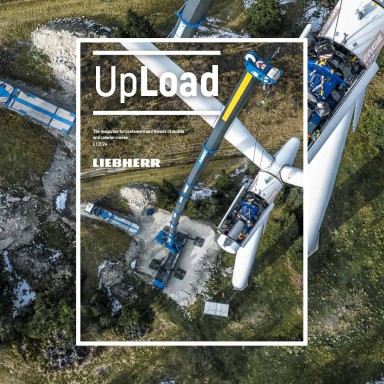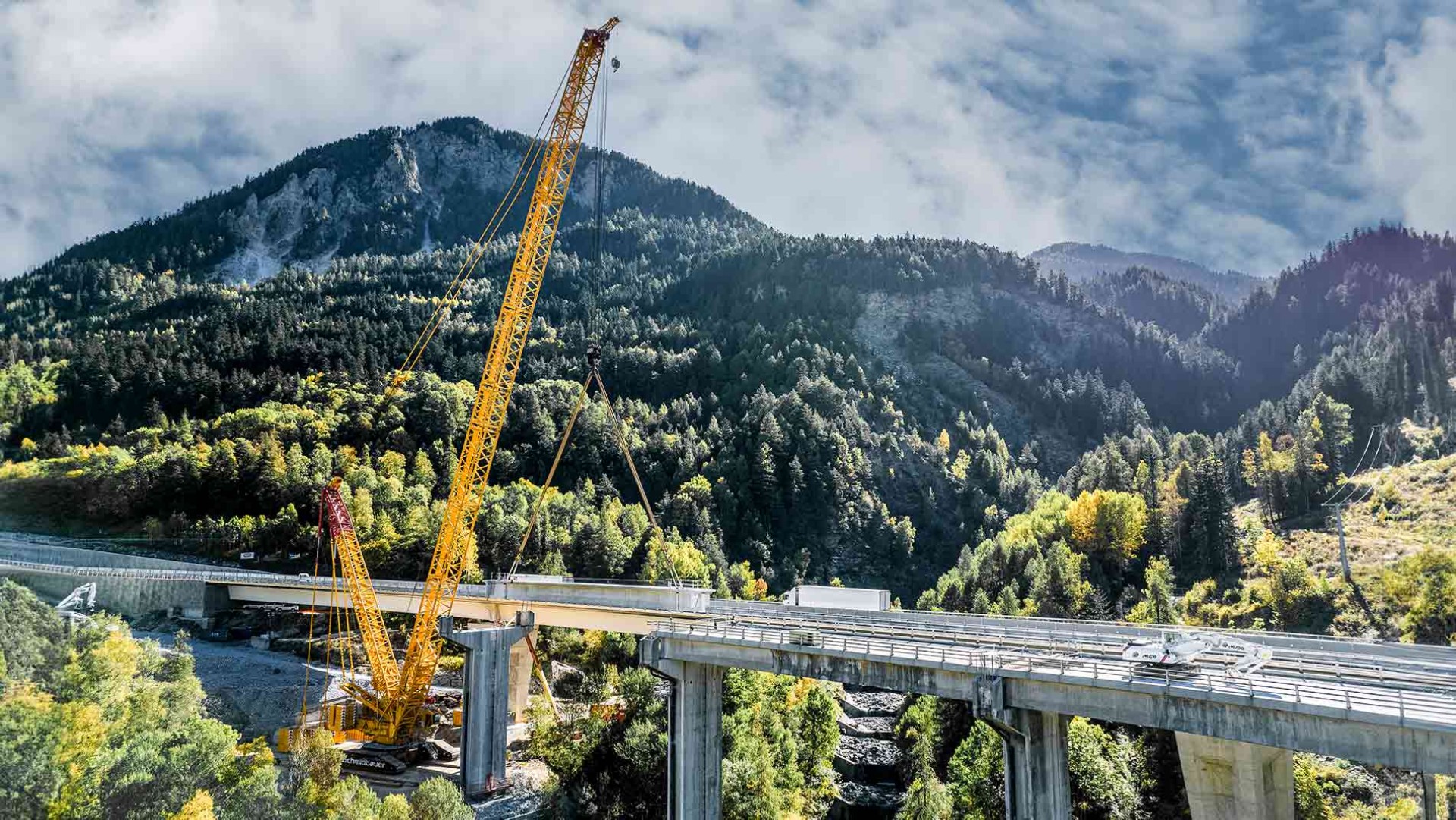
10 minutes - magazine 01 | 2024
Logistical masterpiece in the Alps
The dismantling of a huge motorway bridge between Grenoble and Turin by a Liebherr LR 11350 crawler crane marked the end of an infrastructure problem in the Franco-Italian border region that had lasted for over four decades.
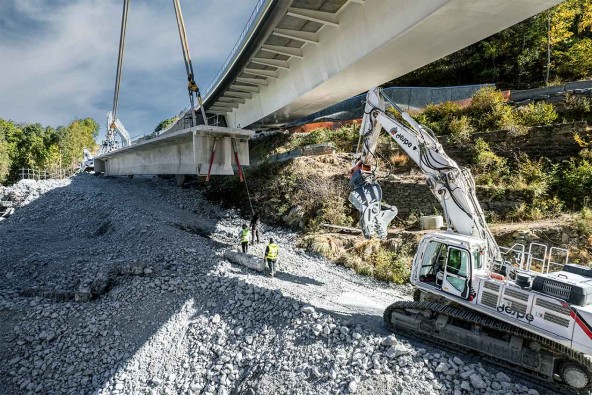
Special transporter takes LR 11350 to the site
The Charmaix Viaduct in the Auvergne-Rhône-Alpes region, built in 1978, had to be replaced due to structural problems. Last summer, the new structure, which runs parallel to the A43 motorway, was opened to traffic and work began on dismantling the old bridge. In autumn, the most powerful crawler crane from German crane and heavy-duty contractor Schmidbauer GmbH & Co. KG then lifted the last girders off of the highest pillars. The challenges involved in assembling the Liebherr crawler crane on the mountainside were immense.
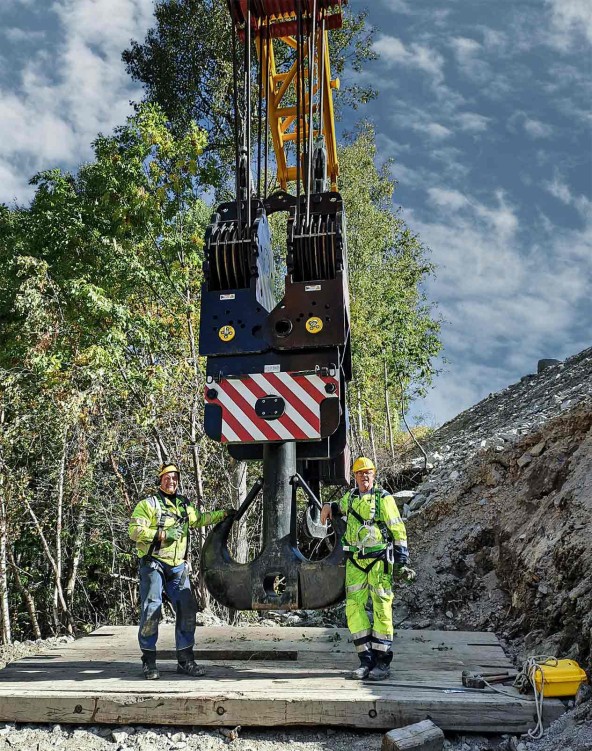
Made of steel - is the 18 tonne hook block of the LR 11350. Perhaps also the Schmidbauer crew, who did the arduous job in the French mountains with aplomb. Image featuring: Oliver Thum, External Technical Team (right) and crane driver Fabian Ueck.
An unsurfaced and winding gravel road with a gradient of 25 percent in places. This was the relentless hurdle over the last hundred metres that all the crane parts had to overcome on their way to the construction site. Steep downhill to the site where the Liebherr LR 11350 crawler crane had to be set up for its demanding deployment in a very limited space. Large boom sections were brought down the roughly 30 metres, as were the heaviest components of the large crane: the almost 15-metre-long crawler carriers with gigantic unit weights of 72 tonnes. “A total of 80 heavy goods vehicles arrived at the site. And no space for parking, turning or storage. It was amazing!”
The person telling us this is Oliver Thum, External Technical Team at Schmidbauer who is also an “old hand” in the crane business. Thum, who started his career at Liebherr in Ehingen in 1977 as a teenager with an apprenticeship as a machine fitter, was involved in the dismantling of the motorway viaduct in the French Alps on the crane side. “The absolute challenge for us here was the rough terrain,” reports Thum. “And not just when bringing in the crane parts. The assembly of the lattice booms in particular demanded a lot from us.”
Logistical masterpiece
Due to the aforementioned difficult topography and lack of storage space, delivery and assembly of the enormous machine had to go hand in hand. A huge logistical challenge in itself. Almost all the material that was delivered from Marseille – where the brand new crane had its first job – had to be reloaded above the dusty gravel road and transported bit by bit to the valley floor using a special four-wheel-drive transporter. An arduous and timeconsuming endeavour.
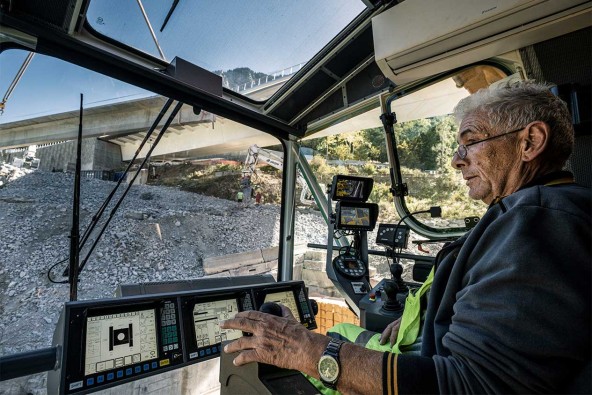
Routined & focussed - Frank Wache at the controls has one of the old girders on the hook, which he now has to set down on the scree slope. The powerful teeth of the excavators then finish off the mighty reinforced concrete trusses on the ground.
Setting up the crane: Three weeks instead of three days
The assembly of the boom proved to be extremely difficult when setting up the crane. The derrick boom and the 108-metre-long main boom had to be assembled partly on a floating basis, i.e. suspended in the air. Due to a lack of levelled and horizontal surfaces, the Schmidbauer crew managed this strenuous undertaking along the steep access road. “We worked our tails off, uphill and downhill,” says Thum. With the help of several demolition excavators on site, the rough terrain was “adapted to the crane” several times for assembly of the gigantic lattice boom. The construction work took a full three weeks. “Normally, we can set up this configuration in around three days,” says Oliver Thum.
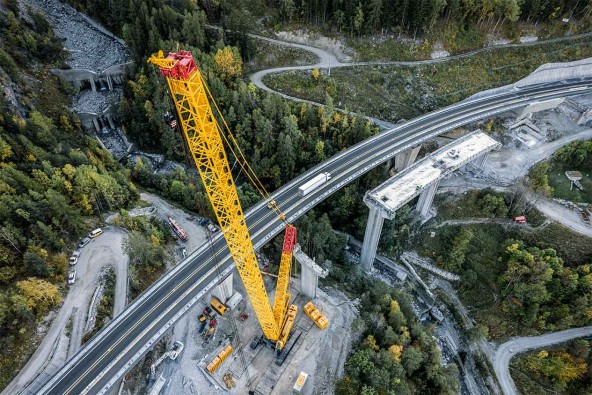
Overview - The LR 11350 has already emptied the first of the three truss bays here with its lattice boom over 100 metres long. Two others are waiting to be dismantled after 45 years of service. The bird’s eye view illustrates how cramped the usable space is for the large crawler crane. A few metres away, the new viaduct is already carrying traffic.
Finally, however, the LR 11350 towered over the valley, visible from afar and ready to lift. Work on dismantling the remains of the old “Viaduc du Charmaix” could begin. Commissioned in 1978, the originally 350-metre-long prestressed concrete structure caused major problems right from the start. And a lot of work. The stability of the underground of slate rubble was incorrectly assessed during the planning phase and the bridge pillars between the two mountain slopes were not anchored deep enough. Just two years after commissioning, some of the girders had already shifted a few centimetres. Investigations revealed that the bridge pillars were moving downhill with the rubble layer. Since then, the affected pillars have been realigned at their foundations in three technically very complex operations, but ultimately the new building – that has now been completed – was decided upon.
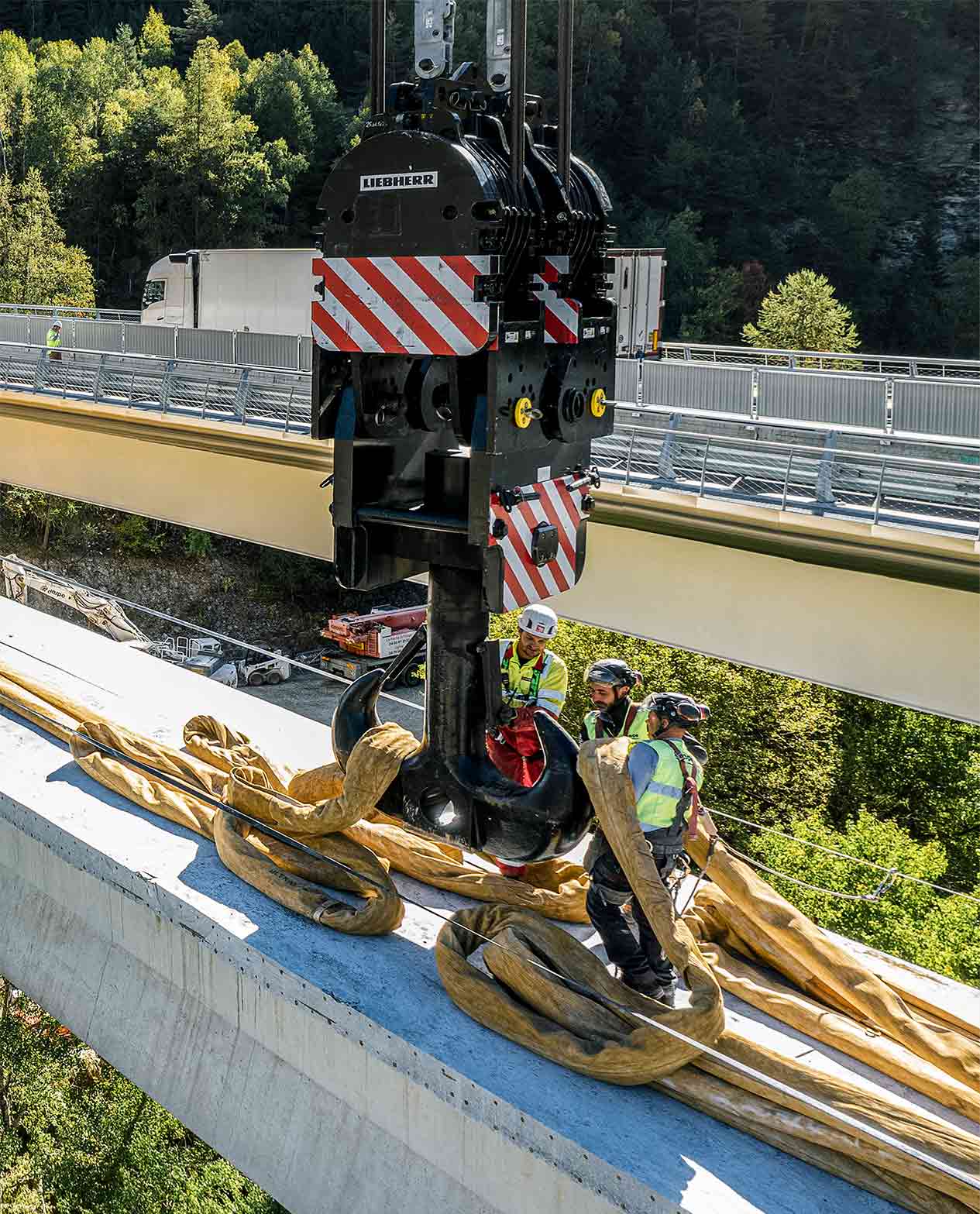
Huge and weighty - are the lifting means between the hook block and the load. High above the valley, the men heave these thick, sheathed steel cables over the hooks. Here, Simone Agostinetto (left) from the Dutch heavy haulage company Mammoet assists with the attachment of the next girder. Mammoet was responsible for the crane work during the dismantling of the viaduct. As the Dutch company did not have a suitable crawler crane in its own fleet for this bridge dismantling project, the LR 11350 from Schmidbauer was booked.
Crane travels with 245-tonne load on the hook
The crawler crane was needed during the dismantling of the disused structure to lift the huge concrete girders off the high pillars in the centre of the valley. Three girder bays, each with four trusses, had to be cleared and gross loads of around 245 tonnes had to be handled. In the two closest sections, the LR 11350 single-handedly managed the recovery of the 40-metre road sections. Equipped with up to 950 tonnes of ballast, the machine could handle overhangs of up to 70 metres. The most distant girders were finally lowered to the ground together with a 700-tonne mobile crane in a tandem lift.
In the cab of the LR 11350, crane drivers Frank Wache and Fabian Ueck took it in turns to hold the joysticks. The two were entrusted with the tricky job of carefully removing the trusses from the old bridge and placing them on the scree of the steep slope after a 180-degree turn. Due to the confined space, the crawler carriers had to cover a distance of around ten metres on the Bongossi base to allow the counterweight frame suspended from the derrick boom to swing through. After setting down the concrete section, four demolition excavators eagerly set to work on the reinforced concrete to make room for the next salvaged bridge section.
The crane and the Schmidbauer team spent around three months working in the Alps. By mid-December, the old viaduct had disappeared.
This article was published in the UpLoad magazine 01 | 2024.

